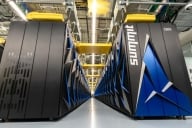You have /5 articles left.
Sign up for a free account or log in.
This week I had a chat with the founders of Eleven Learning, a Cambridge Mass based startup with ambitions to re-engineer the economics of the textbook market. Eleven Learning's goal is to create a structure in which costs are systematically engineered out of the textbook production process. The result will be not only lower costs, but a great diversity and variety of textbooks.
The Eleven Learning guys tried to explain (by phone and e-mail) the cost factors associated with the traditional textbook market. I found their explanation fascinating, and will do my best to synthesize how textbook economics work. Please let me know where I've gotten the story wrong (and any mistakes in the particulars below are my own responsibility).
Textbook costs are driven by two factors, the "plate" or "plant" costs and the "PPB" (paper, print, and bind) costs.
The editorial and production costs are included in the "plate." Editorial costs include all the work that goes into recruiting the author, developing the manuscript, editing, peer review, copyedit, proofread, supplements, class-testing, project management, permission clearance and much else. For a "mid-market" textbook, the editorial costs can easily hit $100,000 (although there is much variation).
Production costs involve everything related to producing the final manuscript that will be turned over to the printer. This work covers design, layout, composition, art creation and management, permissions clearance etc. All this can work can easily swallow another $75,000 or so.
The PPB side (paper, print, and binding) includes all the costs related to the physical printing of the book (paper, binding, shipping, packaging etc.). Costs vary enormously depending on the quality of the paper, the size of the print run, and the market power of the publisher.
The development of a new textbook can easily cost a couple of hundred thousand dollars. The publishers then price their textbooks to earn a profit margin of about 65%, a necessary markup because of the systems high fixed costs and the fact that they make zero money on used textbook sales. The result is expensive textbooks, and a limited number of titles because of the high numbers that need to be sold to make a positive return on the production investment.
The traditional textbook market seems to follow many of the basic rules of media and publishing, relying on a few mega-hits to pay for textbooks that never earn back their initial investment. Textbooks with little chance of succeeding (and I'm not sure what constitutes success - 25 thousand units a year?), never make it into production.
As I understand Eleven Learning's model, they plan to pursue a long tail strategy of textbook publishing by eliminating many of the costs associated with the development of the textbook. They hope to move much of the editorial costs towards a community model, embracing an open publishing and crowd-sourced model to guide the production and quality control aspects of manuscript development. According to the Eleven Learning website, they are developing a platform that allows " …crowdsourced commenting tools [that] will enable you to upload your manuscript and invite reviewers to comment and suggest improvements. The feedback comes directly from those whose opinions matter most: potential adopters of your book". They also believe they can trim the per-unit costs of textbooks by starting with a digital and print-on-demand model, eliminating the high fixed legacy costs of a paper based publishing model.
The real test in any startup is not the ideas (although I think Eleven Learning has some great ideas) but the quality of execution. We have not seen the platform that will enable a textbook to be written with immediate and relevant feedback from a specific academic discipline. Nor do we know if Eleven Learning will succeed in developing a community large and active enough to bring this wisdom of crowds to the editing of a textbook. It is not clear to me how much of the professional editorial costs can be reduced without sacrificing quality. The danger seems to be producing textbooks of uneven quality, and therefore making it difficult to trust the content. A sort of Wikipedia problem.
I'm happy, however, that a startup is taking on the problem of textbook production - and not restricting themselves to the delivery side. Sure, Eleven Learning will probably produce an iPad app - but the innovations they hope to introduce are more fundamental to the textbook industry. We need more startups like Eleven Learning.
Do you know of other startups in the educational technology and publishing space that should be on our radar? What advice would you give to Eleven Learning?








